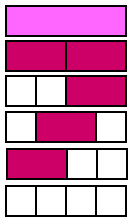Rods and rods
Problem
I've been playing around with cuisenaire rods, this is what I came to.
There are five different ways for us to make the pink rod using just red and white rods.

We count white, white, red as different from the white, red, white even though they both use two white rods and one red rod.

Using our Cuisenaire environment, can you work out how many different ways there are, using only the red and white rods, to make up:
- The light green rod?
- The yellow rod?
- The dark green rod?
- The black rod?
Without using the interactivity, how many different ways are there to make up the orange rod (equivalent to 10 white rods)?
Can you explain the pattern?
Getting Started
Pick any colour of rod. Consider how many different ways there are to make it with a white rod on the right-hand end, and how many ways there are with a red rod on the right-hand end.
Student Solutions
Well done to Hannah who sent in this generalisation:
Using the red and white blocks only, you add together the amounts of ways to form the two previous blocks:2 ways to form the red block + 3 ways to form the light green block
= 5 ways to form the pink block
Using the red, white and light green blocks only, you add together the amounts of ways to form the three previous blocks:
2 ways to form the red block + 4 ways to form the light green block + 7 ways to form the pink block
= 13 ways to form the yellow block
It is interesting to think about why this happens.
You can use similar reasoning to explain Hannah's other solution regarding the use of red, white and light green blocks.
Teachers' Resources
Why do this problem?
This problem can help pupils extend their spatial understanding related to number sense. It can be used to acquaint pupils with the attributes of the cuisenaire rods.
Possible approach
A time to play with the rods if pupils are not used to using them would be essential. If you do not have access to the rods then pupils could have some time with the general cuisenaire environment to be found here. The challenge could begin my working on the pink rod ideas altogether and having some clear discussion as to why the two examples shown
lower down although using the same rods are counted as different.
The pupils can then work indiviually or in groups to tackle the other questions.
Key questions
Do you think there are any more to find?
Are any of yours the same? (Good to ask both when there is and is not a slip-up in their examples)
Tell me about how you found these.
Possible extension
Suggest other different coloured pairs of rods that could be tested to see if they can be put together to equal the largest of the rods.
Two bigger rods can be put together for a much longer length for the pupils to try to work on using pairs of different rods (see here below)

